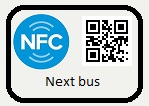What do contact points give me?
There are three principal benefits from deploying contact points:
- Your customers get information they need at the point of need, easily.
- You get more usage and therefore value from your investment in online information services, without having to do any new development.
- Contact points are a new channel for communication with your customers and prospective customers - messages from you and feedback from them.
What happens at a contact point?
A user at one of your contact points will see a sign showing the opportunity for contact and offering some mechanisms - typically a QR code and/or an NFC tag.
Example: Bus departures

Such signs might be displayed at a bus stop. They provide a motivating tag-line offering immediately relevant information - how long to wait - in return for a trivial effort by the user - i.e. scanning the QR code or tapping the NFC tag.
The web address reached may be simply an existing one providing live departure information from that exact stop, that the user would normally find with greater effort by navigating the bus company web site - or a wrapper on that existing web address facilitating a dialogue with the user (This bus use case is explored in more detail in How it works).
Contact points like this can not only increase customer goodwill, and usage of the online information, but are also an opportunity to solicit some feedback from the customer about their experience of the bus service. They are far cheaper to deploy than electronic information boards and offer richer content, not least because the content offered can be customised to the individual user.
How are contact points implemented?
First of all, each contact point is assigned a web address or URL for the information specific to that contact point. The various techniques described here are simply different ways that URL can be passed to a user's device so they can access the web content without needing to enter a web address.
QR codes
QR codes are two-dimensional patterns designed to be easily readable by computers, like the familiar bar codes on consumer products. QR codes are more easily readable and can carry more information than bar codes.
A QR code is typically displayed at the contact point in a conspicuous and accessible way, e.g. on a wall poster.
There are numerous free apps for smartphones that allow users to capture the QR code information with the camera on their device, and open their browser to the underlying URL.
These apps are available for all smartphone types and are the only universal solution for contact points, although not the most convenient.
X-MR conducted a Google survey in June 2014 amongst 200 UK Android smartphone users and found that 71% had used their phone to scan a QR code.
NFC tags
NFC or Near Field Communication is a wireless technology for transferring data between suitably equipped devices.
NFC tags are small flat devices containing some microcircuitry and an aerial that permit a small amount of data stored in the tag (such as a web address) to be read by an active device like a smartphone.
For contact points NFCs are usually embodied in stickers or panels that are secured to some fixture at the contact point, though they can be and usefully are attached to mobile assets as well. There are various ways NFC tags can be programmed, including using an app on an NFC-equipped smartphone.
Modern smartphones (but not Apple devices) include NFC readers. These devices can pick up a URL from a tag just by contact without requiring to user to install or activate an app.
X-MR conducted a Google survey in June 2014 amongst 200 UK Android smartphone users and found that 29% had used their phone to tap an NFC tag. NFC is the basis for contactless payment systems which are getting widespread acceptance.
iBeacons
T.b.a.
Geo-fences
T.b.a